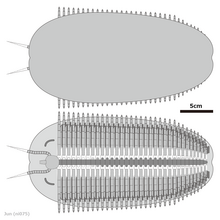| Tegopelte Temporal range: Middle Cambrian PreꞒ Ꞓ O S D C P T J K Pg N | |
|---|---|

| |
| Holotype | |

| |
| Diagrammatic reconstruction, showing top-down view (top) and view from below (bottom) | |
| Scientific classification | |
| Domain: | Eukaryota |
| Kingdom: | Animalia |
| Phylum: | Arthropoda |
| Subphylum: | †Trilobitomorpha |
| Subclass: | †Conciliterga |
| Genus: | †Tegopelte Simonetta and Delle Cave, 1975 |
| Species: | †T. gigas |
| Binomial name | |
| †Tegopelte gigas Simonetta and Delle Cave, 1975 | |
Tegopelte gigas (from the Greek tegos, “tile,” and pelte, “leather-shield,” referring to the shape of the dorsal body covering; gigas – from the Greek gigas, “giant,” due to the huge size of the animal) is a species of large soft-bodied arthropod known from two specimens found in the Middle Cambrian Burgess Shale of British Columbia, Canada.
Description
Tegopelte was a large arthropod, reaching a body length of 28 centimetres (11 in) and width of 14 centimetres (5.5 in). The body was covered in a large undivided dorsal shield that was unmineralised. On the head a pair of tear-shaped eyes were present on the underside of the shield, along with a pair of antennae. The body had 33 pairs of biramous limbs, with the lower endopod functioning as the walking limbs, though the ones at the far back of the body are likely too small to have been useful for walking. The endopods had at least four segments/podomeres. The exopods of the limbs pairs bore elongated filament-like structures, and probably functioned as gills. Within the body were gut diverticulae used to digest food.
Ecology

Tegopelte is suggested to have been a seafloor dwelling (benthic) animal that was either a predator or a scavenger. Trackways probably produced by Tegopelte are known from the Kicking Horse Shale, stratigraphically below its body fossil occurrences. These suggest that it had the ability to skim along the seafloor at a brisk pace and could perform tight turns, though the tracks suggest that they also at times more slowly walked across the seafloor.
Taxonomy
Although historically classified as a true trilobite, is no longer thought to be part of this group. It is currently considered a member of the clade Conciliterga within Trilobitomorpha, a group which contains trilobites and their close relatives.
After Jiao et al. 2021.
| Artiopoda |
| |||||||||||||||||||||||||||||||||||||||||||||||||||||||||||||||||||||||||||||||||||||||||||||||||||||||||||||||||||||||||||||||||||||||||||||||||||||||||||||||||||||||||||||||||||||||||||||||||||||||||||||||||||||||||||||||||||||||||||||||||||||||||||||||||||||||||||||||||||||||||||||||||||
See also
References
- Tegopelte gigas. A giant trilobite-like arthropod. The Burgess Shale.
- ^ Nicholas J. Minter, M. Gabriela Mángano & Jean-Bernard Caron (2011). "Skimming the surface with Burgess Shale arthropod locomotion". Proceedings of the Royal Society B: Biological Sciences. 279 (1733): 1613–1620. doi:10.1098/rspb.2011.1986. PMC 3282348. PMID 22072605.
- ^ Harry B. Whittington (1985). "Tegopelte gigas, a second soft-bodied trilobite from the Burgess Shale, Middle Cambrian, British Columbia". Journal of Paleontology. 59 (5): 1251–1274. JSTOR 1305016.
- Jiao, De-Guang; Du, Kun-Sheng; Zhang, Xi-Guang; Yang, Jie; Eggink, Daniel (May 2022). "A new small soft-bodied non-trilobite artiopod from the Cambrian Stage 4 Guanshan Biota". Geological Magazine. 159 (5): 730–734. Bibcode:2022GeoM..159..730J. doi:10.1017/S0016756821001254. ISSN 0016-7568.
External links
- "Tegopelte gigas". Burgess Shale Fossil Gallery. Virtual Museum of Canada. 2011. Archived from the original on 2020-11-12.
| Artiopoda | ||
|---|---|---|
| ||

 | ||
| Taxon identifiers | |
|---|---|
| Tegopelte | |
This prehistoric arthropod–related article is a stub. You can help Misplaced Pages by expanding it. |

